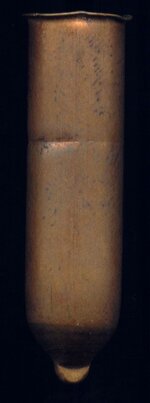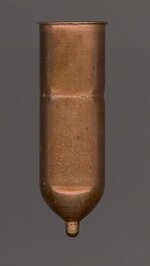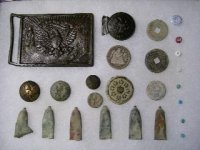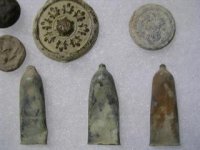Navigation
Install the app
How to install the app on iOS
Follow along with the video below to see how to install our site as a web app on your home screen.
Note: This feature may not be available in some browsers.
More options
You are using an out of date browser. It may not display this or other websites correctly.
You should upgrade or use an alternative browser.
You should upgrade or use an alternative browser.
✅ SOLVED what are these??
- Thread starter Darby
- Start date
TheCannonballGuy
Gold Member
- Feb 24, 2006
- 6,591
- 13,351
- Detector(s) used
- White's 6000, Nautilus DMC-1, Minelab
- Primary Interest:
- Relic Hunting
The small crushed brass cylinders with a "teat" on the rounded end appear to be Williamson Patent 1864 "Teatfire" bullet-cartridges. They were made for use in a civil war era Moore revolver, and came in .32 and .45-caliber. See the photos below. Based on their size in the photo compared to your fingers, yours appear to be the .32-caliber version.
Attachments
Upvote
0
Darby
Hero Member
- Mar 31, 2013
- 811
- 884
- 🥇 Banner finds
- 1
- Detector(s) used
- Garrett ATPro
- Primary Interest:
- Relic Hunting
- Thread starter
- #4
The small crushed brass cylinders with a "teat" on the rounded end appear to be Williamson Patent 1864 "Teatfire" bullet-cartridges. They were made for use in a civil war era Moore revolver, and came in .32 and .45-caliber. See the photos below. Based on their size in the photo compared to your fingers, yours appear to be the .32-caliber version.
Thank you sir looks very much like it! Thank you again, your help is always very much appreciated! Any idea about the other piece?
Upvote
0
TheCannonballGuy is spot on with the identification for the "Teat-Fire" revolver cartridge casings. These unusual cartridges and spent casing are often overlooked by the casual observer when found, and at times thought to be everything from the end-cap from a pen to small bells and such.
The unfired cartridge when seen and dug is a very curious item indeed. The bullet in these Teat-Fire cartridges is actually completely down inside the cylinder. To the untrained eye, the cartridge looks more like something a fellow in camp created during boredom, by pushing a bullet into a tube. Quite the contrary though, as these cartridges were in fact top innovation and technology for the 1860's. The slight crimp around the outer perimeter, that may be noted in the photos provided by TheCannonballGuy, is the seat that provided the stopping point for the bullet during the manufacturing process.
National Arms Company of Brooklyn New York, also manufactured revolvers that utilized the Moore & Williamson Patent Teat-Fire cartridge.
The National Arms Company was a Brooklyn New York-based manufacturer of firearms that flourished for a decade in the mid-19th century, around the time of the American Civil War.
Among the weapons it manufactured were a derringer that fired the .41 short (a round it introduced in 1863), and Daniel Moore and David Williamson's Pocket Revolver using the Caliber .31 Teat-fire cartridge (which it made under both the Moore and National Arms marques).[SUP] [1]
[/SUP]
The Moore Caliber .32 Teat-fire, which used a unique cartridge to get around the Rollin White patent owned by Horace Smith and Daniel Wesson, proved very popular during the Civil War, with both soldiers and civilians. The "Teat-fire" cartridges did not have a rim at the back like conventional cartridges, but were rounded at the rear, with a small "teat" that would protrude through a tiny opening in the rear of the cylinder. The priming mixture was contained in the "teat" and when the hammer struck it, the cartridge would fire. Thus, it was akin to a rimfire cartridge, but instead of having priming all the way around the edge of the rim, it is centrally located in the teat.[SUP] [2]
[/SUP]
National Arms produced about 30,000 of the Caliber .32 Teat-fire revolvers from 1864 to 1870, when it was acquired by Colt's manufacturing Company. Colt continued to produce the .41 rimfire derringer after the acquisition as an effort to break into the metallic cartridge gun market.[SUP] [3][/SUP]
CC Hunter
The unfired cartridge when seen and dug is a very curious item indeed. The bullet in these Teat-Fire cartridges is actually completely down inside the cylinder. To the untrained eye, the cartridge looks more like something a fellow in camp created during boredom, by pushing a bullet into a tube. Quite the contrary though, as these cartridges were in fact top innovation and technology for the 1860's. The slight crimp around the outer perimeter, that may be noted in the photos provided by TheCannonballGuy, is the seat that provided the stopping point for the bullet during the manufacturing process.
National Arms Company of Brooklyn New York, also manufactured revolvers that utilized the Moore & Williamson Patent Teat-Fire cartridge.
The National Arms Company was a Brooklyn New York-based manufacturer of firearms that flourished for a decade in the mid-19th century, around the time of the American Civil War.
Among the weapons it manufactured were a derringer that fired the .41 short (a round it introduced in 1863), and Daniel Moore and David Williamson's Pocket Revolver using the Caliber .31 Teat-fire cartridge (which it made under both the Moore and National Arms marques).[SUP] [1]
[/SUP]
The Moore Caliber .32 Teat-fire, which used a unique cartridge to get around the Rollin White patent owned by Horace Smith and Daniel Wesson, proved very popular during the Civil War, with both soldiers and civilians. The "Teat-fire" cartridges did not have a rim at the back like conventional cartridges, but were rounded at the rear, with a small "teat" that would protrude through a tiny opening in the rear of the cylinder. The priming mixture was contained in the "teat" and when the hammer struck it, the cartridge would fire. Thus, it was akin to a rimfire cartridge, but instead of having priming all the way around the edge of the rim, it is centrally located in the teat.[SUP] [2]
[/SUP]
National Arms produced about 30,000 of the Caliber .32 Teat-fire revolvers from 1864 to 1870, when it was acquired by Colt's manufacturing Company. Colt continued to produce the .41 rimfire derringer after the acquisition as an effort to break into the metallic cartridge gun market.[SUP] [3][/SUP]
- 1.) Flayderman, Norm (2001), Flayderman's Guide to Antique American Firearms and their Values, Krause Publications, p. 497, ISBN 978-0-87349-313-0
- 2.) Walter, John (2006). The Guns That Won the West: Firearms on the American Frontier, 1848-1898. MBI Publishing Company. p. 108. ISBN 978-1-85367-692-5.
- 3.) Rick Sapp (2007). Standard Catalog of Colt Firearms. F+W Media, Inc,. pp. 59–60. ISBN 978-0-89689-534-8.
CC Hunter
Last edited:
Upvote
0
BosnMate
Gold Member
- Sep 10, 2010
- 6,916
- 8,441
- Detector(s) used
- Whites MXT, Whites DFX, Whites 6000 Di Pro
- Primary Interest:
- Other
Your item with the silver looks like a front sight for a rifle, except it's so darn large. Judging by your fingers I'd say it's way to large for a rifle sight, perhaps some other type of aiming device. Love the teat fired brass, I've heard of those but never seen one.
Upvote
0
Ironman!
Sr. Member
- Mar 25, 2009
- 381
- 309
- 🥇 Banner finds
- 2
- Detector(s) used
- MXT/Gold Bug Pro
- Primary Interest:
- All Treasure Hunting
Nice finds and not found very often! This is just confirmation to the excellent info. CannonballGuy & CC Hunter already gave. Attached are pics. of 6 .32 caliber cartridges I found in one of my early 1870's sites. I donated 2 of them to Thomas Stelma for another bullet book he was working on but unfortunately he passed away. I have found one more since then which isn't smashed!! Get back out there and try and find a drop!!!
IM
IM
Attachments
Upvote
0
Top Member Reactions
-
 3549
3549 -
 2010
2010 -
 1906
1906 -
 1374
1374 -
 1068
1068 -
 1031
1031 -
 937
937 -
 919
919 -
 907
907 -
 754
754 -
 733
733 -
 616
616 -
 578
578 -
 551
551 -
 476
476 -
 465
465 -
 422
422 -
E
405
-
 395
395 -
 357
357
Users who are viewing this thread
Total: 2 (members: 0, guests: 2)













